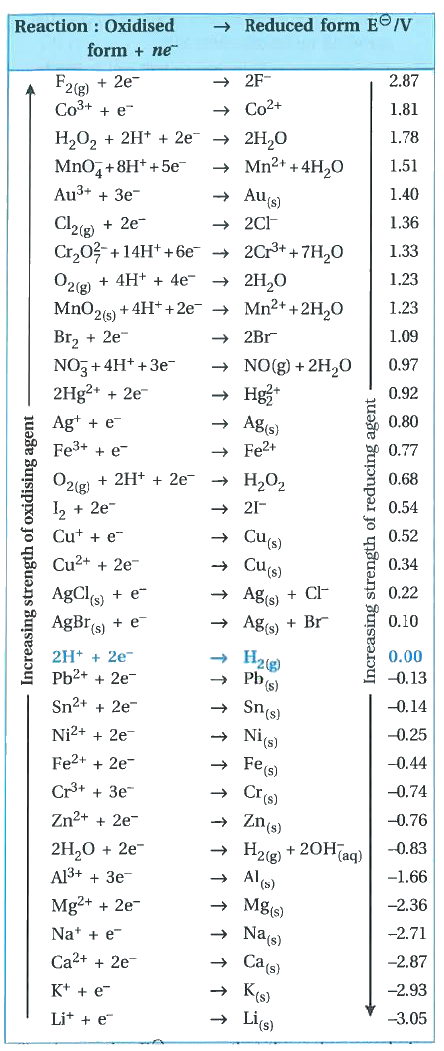What is the standard electrode (Half-cell) potential ? Give its uses.
Potential of standard electrode (Half-cell):
Standard condition means at 298K temperature and 1 bar pressure of gases and 1M concentration of solution, the reproduction potential of electrode (Half-cell) is called as standard electrode potential which has volt unit.
Construction of emf series: When half cell reaction are arranged in a decreasing order of their standard reduction potential then such series of half-cell is known as emf series. it is as follows :

(i) A negative EΘ means that the redox couple is a stronger reducing agent than the H+∣H2 couple.
(ii) A positive EΘ means that the redox couple is a weaker reducing agent than the H+∣H2 couple.
Determine the stability order of reduction form:
If the standard electrode potential of an electrode is greater than zero then its reduced form is more stable compared to hydrogen gas.
E.g., stability order: Ag>Cu>H2
If the standard electrode potential is negative then hydrogen gas is more stable than the reduced form of the species.
e.g., stability order : H2>Pb>Sn>Ni>Fe>Cr>Zn
(iii) To determine strength as oxidizing-reducing agent:
Positive EΘ: The standard electrode potential for fluorine is the highest in the Table indicating that fluorine gas (F2) has the maximum tendency to get reduce to fluoride ions (F−) and therefore fluorine gas is the strongest oxidising agent and fluoride ion is the weakest reducing agent.
Negative EΘ: Lithium has the lowest electrode potential indicating that lithium io is the weakest oxidising agent while lithium metal is the most powerrful reducing agent in an aqueous solution.
Note: The standard electrode potential decreases and with this, decreases the oxidising power of the species on the left and increases the reducing powre of the species on the right hand side of the reaction e.g., F2 is strong oxidizing agent and F− is strong reducing agent.
(iv) To determine the possibilities of reaction : The half-cell with high standard reduction potential will give more reduction reaction with respect to less standard reduction potetnial, which gives reduction reactions.
EΘ(Cu2∣Cu)=+0.34VandH+∣H2(g) of EΘ=0V
[EΘ(Cu2+∣Cu)>EH+∣H2]
So H+ ion can.t oxidize Cu. and so Cu metal can.t be dissolved in HCl.
2H+(aq)+Cu(S)→Reaction will not occurs
But H2(g)+Cu2+(aq)→2H++Cu(S) reaction will occur
Hydrogen gas can reduced copper ion into copper metal.
Reduction: Cu2+(aq)+2e−→Cu(S)(EΘCu2+∣Cu More)
Oxidation :H2(g)→2H+(aq)+2e−(ECu2+∣Cu Less)
Note: Oxidation of Cu metal into Cu2+ ion is possible by nitrate ions of nitric acid.
Topper's Solved these Questions
- ELECTROCHEMISTRYBOOK - KUMAR PRAKASHANCHAPTER - ELECTROCHEMISTRYEXERCISE - SECTION-A (Try Yourself)
25 Videos
- ELECTROCHEMISTRYBOOK - KUMAR PRAKASHANCHAPTER - ELECTROCHEMISTRYEXERCISE - SECTION-A (Practice Questions)
3 Videos
- ELECTROCHEMISTRYBOOK - KUMAR PRAKASHANCHAPTER - ELECTROCHEMISTRYEXERCISE - SECTION-E MCQ.s Asked in GUJCET/Board Exam
55 Videos
- CHEMISTRY IN EVERYDAY LIFEBOOK - KUMAR PRAKASHANCHAPTER - CHEMISTRY IN EVERYDAY LIFEEXERCISE - SECTION - E (MCQs ASKED IN GUJCET/BOARD EXAM)
37 Videos
- GENERAL PRINCIPLES AND PROCESSES OF ISOLATION OF ELEMENTSBOOK - KUMAR PRAKASHANCHAPTER - GENERAL PRINCIPLES AND PROCESSES OF ISOLATION OF ELEMENTSEXERCISE - SECTION - E (MCQs ASKED IN GUJET/BOARD EXAMS)
46 Videos
Similar Questions
The standard EMF of the cell : Ni|Ni2+∣∣∣Cu2+∣∣Cu
is 0.59 volt The standsard elctrode potential (reduction potential of copper electrode is 0.34 volt . Calculate the standsard electrode potential of nickel electrode
View SolutionCalculating the emf from standard potentials:
A galvanic cell consists of an Al electrode in a 1.0MAl(NO3)3 solution and an Fe electrode in a 1.0MFe(NO3)2 solution. Calculate the standard emf of this electrohemical cell at 25∘C. Also write the cell reaction.
Strategy: From the table of standard electrode potentials, write the two reduction half reaction and standard electrode potentials for the cell. Change the direction of the half-cell reaction corresponding tol the smaller (or more negative) electrode potential. Multiply the when the half-reactions are added the electrons cancel. The sum of the half-reactions is the cell reaction. Add the electrode potentials to get the cell emf.
View Solution
Knowledge Check
Standard electrode potential of an electrode is :
AIntensive propertyBExtensive propertyCIsothermal propertyDIsobaric propertyAssertion: A negative value of standard reduction potential means that reduction takes place on this electrode with reference to standard hydrogen electrode.
Reason: The standard electrode potential of a half cell has a fixed value.Aif both assertion and reason are true and the reason is the correct explanation of the assertion.BIf both assertion and reason are true but reason is not the correct explanation of the assertion.CIf assertion is true but reason is falseDIf assertion is false but reason is true.Standard cell electrode potential is expressed as
AE0cell=E0red(R.H.S.)−E0Oxi(L.H.S)BE0cell=E0red(L.H.S.)+E0Oxi(R.H.S)CE0cell=E0oxi(Anode)+E0Oxi(Cathode)DE0cell=E0red(R.H.S.)+E0Oxi(L.H.S)
Give electrode reactions of mercury cell. Give its uses.
View SolutionWhich cell will measures standard electrode potential of copper electrode ?
View SolutionWhich cell will measure standard electrode potential of copper electrode?
View SolutionWhich cell will measure standard electrode potential of copper electrode?
View SolutionWhich cell will measure standard electrode potential of copper electrode?
View Solution
